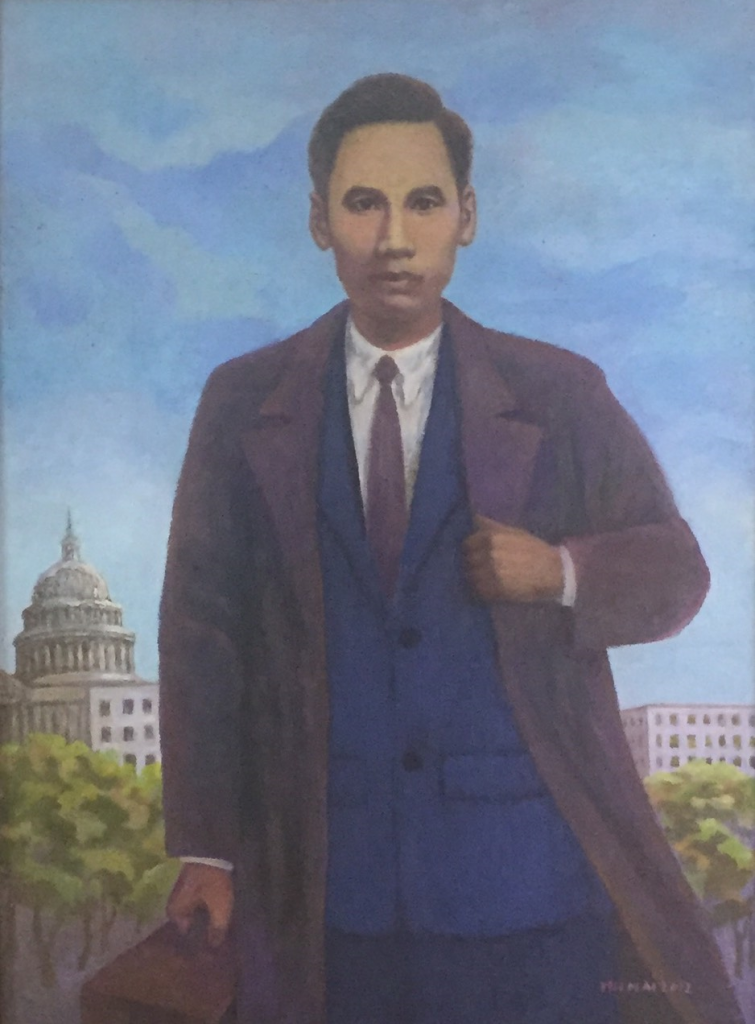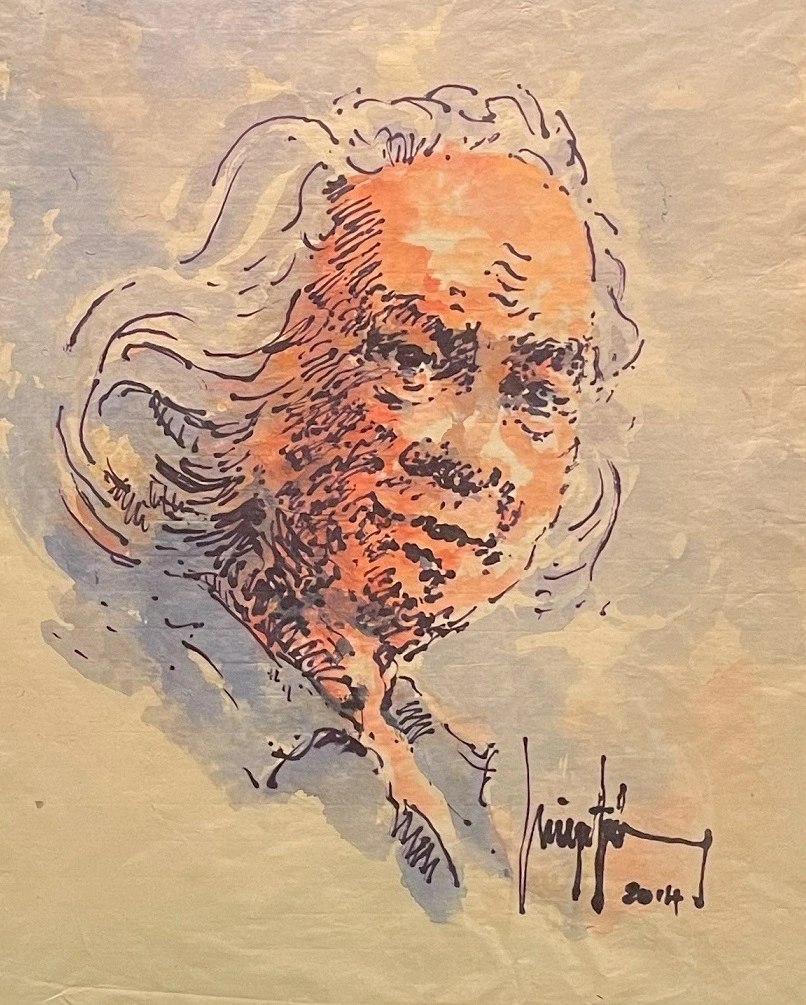The fine art career of artist and journalist Hoàng Hoa Mai must be mentioned with the portrait paintings of kings, heroes of the nation, and especially the subject of President Hồ Chí Minh that he has spent a lot of time on research and composition over the past decades. The compositions of portraits of Bà Triệu, Lê Hoàn, Lê Lợi, Nguyễn Trãi, Hồ Quý Ly, Lê Văn Hưu… are respectfully appreciated by the Thanh people and domestic public, both in terms of ideological content and art. He has had many works printed, published in newspapers, magazines and displayed in many central and local museums. The artist has had works in the national art exhibition 7 times (every 5 years), including 4 works about Uncle Hồ. He is one of the few artists in the country who painted many and succeeds on the subject of Uncle Hồ.
The works Uncle Hồ with the red pencil (oil painting), national art exhibition in 1990, Uncle Hồ writing the declaration of independence (oil painting), national art exhibition in 2009 on the theme “Study and follow Hồ Chí Minh’s moral example” in Hà Nội; Nguyễn Ái Quốc (oil painting), national art exhibition in 2005 and displayed at the Hồ Chí Minh Museum, Uncle Hồ on top of Trường Lệ mountain (oil painting), national art exhibition in 2010, version one kept in Museum of Thanh Hóa, version two kept in National History Museum of Việt Nam; Uncle Hồ at his talk with resistance officers in Thanh Hóa in 1947, national art exhibition in 2020.
Artist Hoàng Hoa Mai’s consistent viewpoint when creating and painting the subject of Uncle Hồ is to only recreate events where there are no photos of Uncle Hồ coming to live and work, the artist only relied on history and people’s accounts to build the work. With that mindset of representing, the artist recently created the work Nguyễn Tất Thành in America.
The painting is a work that the artist has diligently researched and collected materials for many years. This work is also part of the line of expressive paintings that represent history, but there is no photographic documentation and there is not even much written documentation about Uncle Hồ in America.
The artist’s way to identify the problem is why in reality there was such a big event and we don’t have any photos of Nguyễn Tất Thành working in the US to save for history. Therefore, using the painting method to represent His portrait is very necessary. By doing so, generations of today and future will be able to imagine what Uncle Hồ was like when He was in a foreign land, traveling overseas to seek a way to save the country and the people.
This is a difficult topic, because there is no visual documentation and there is not much written description of Him. Information about Uncle Hồ at that time is very little, especially there is no photo taken with anyone remains with related people in the US or France. Therefore, when describing the portrait of Nguyễn Tất Thành in America, the artist had to exploit photo documents at a time of around 5 or 6 years, such as: Brother Ba on the Lalouchetreville ship, when He arrived in Paris, there are some pictures but in general, it is not clear, it is difficult to represent His portrait in 1912 as expected.
Winter in December in the United States is very cold, so the clothes that Nguyễn Tất Thành used were vest, jacket, black leather shoes. The composition and structure of the painting is where He stood in front of the US Capitol, in a state of deep contemplation about American capitalist society full of chaos, brutal beatings, exploitation and injustice. Just like the French, who always boast of human rights, enlightenment and civilization, bringing freedom and prosperity to the Vietnamese people, that is an American-style deception and lie that the West was applying to the colonial country. All of these images in the young man’s eyes are the indignation and condemnation of capitalist imperialism and raising the will to overcome all difficulties and obstacles to find a way saving the country and the people from the brutal colonial rule, all is expressed in the portrait of Nguyễn Tất Thành.

Nguyễn Tất Thành in America – Oil painting of artist Hoàng Hoa Mai
Depicting a person with a passionate patriotic heart, a great ideal, a great personality for the country and the people, Nguyễn Tất Thành, had to go abroad to seek the way for revolution while his nation was immersed in a long dark with the domination of French. This is a very difficult subject to represent. Many documents say that around the end of 1912, Nguyễn Tất Thành arrived in the east of United States on the ship Latusotorevin and from there he traveled to Africa and Europe, wherever he went he witnessed scenes of exploitation and brutally beating on the poor workers of the rich capitalists, people of color as well as white people in any continent: Europe, Asia, Africa, America, the people suffering the most are still the hard-working people, they just worked hard all day long without enough food or clothing. The disparaging and racist on people of color and abusive treatment are attributes of capitalism that Nguyễn Tất Thành witnessed directly across many continents. Traveling to many places in the world, reflecting on the land of Việt Nam, those scenes of cruel exploitation are no less. Therefore, in order to liberate the nation, bring independence, freedom, and happiness to the people, it must be a revolution to save the country, which Nguyễn Tất Thành had in mind right when he was a child. A quality of revolutionary outlook on life, present from an early age, so He felt why our people were poor, why they were ruled by Westerners, why they were exploited to the core, beaten and driven away? All those images caused anger in this young man who had to go abroad and seek a way to save the country, expel the French imperialists and bring freedom and independence to the nation.
The artist has spent a lot of time and effort researching documents about Nguyễn Tất Thành’s revolutionary ideology and determination to recreate His portrait using the painting method and experience in anatomy. This is a difficult job, so the artist had to research for a long period of decades, reading books and newspapers about Nguyễn Ái Quốc and Nguyễn Tất Thành to find facts that could be approached realistically. In many different documents, one thing in common is that in the late winter of December 1912, Nguyễn Tất Thành was 22 years old, came to the United States and visited many places including the US Capitol and the Statue of Liberty. Wherever He went, He witnessed scenes of harshness and disregard for black manual workers, it expressed on His face, sympathy for the hard-working people, but also anger at the imperialists. When expressing the portrait of Nguyễn Tất Thành, that spirit must be incorporated into the structure of creating His portrait with a scientific basis in every detail.
Comparing the photos in the documents during His years in France, although very few and not clear, the artist had to use the logic of the art of painting to describe using oil paint to be able to express His thoughts and feelings at that time. With a kind face and bright eyes, Nguyễn Tất Thành wondered when looking at the monument of freedom, the US Capitol, and the artistic architecture that spoke of freedom, equality, and fraternity, but it was full of injustice and brutality of American capital. The picture is that when He arrived in America, it was a cold winter (late December), carrying a suitcase, wearing a black suit, holding the lapels of a the jacket. The space and time represented is Nguyễn Tất Thành standing in front of the square of the US Capitol. He felt that inside was a place to discuss invasion plots and harsh exploitation not only in the country but also in the colonial countries around the world.
In order for the work to properly reflect the time and space, the artist arranged the entire painting in a cold color scheme, reminding the viewer to feel the dark social nature like a gray “American civilization” which Nguyễn Tất Thành clearly understood.
After many years of researching documents and sketching many times, the painting was completed in early 2018 and displayed in an exhibition in Hà Nội organized by Hà Nội Fine Arts Association in 2018. The work has been preserved and displayed at Hồ Chí Minh Museum (Nhà Rồng Waterfront) in Hồ Chí Minh City, introduced in many newspapers, radio and television. This is also the wish of artist Hoàng Hoa Mai, member of painting branch, Việt Nam Fine Arts Association, who has been thinking for many years to create the painting Nguyễn Tất Thành in America.
Written by Thu Trang







